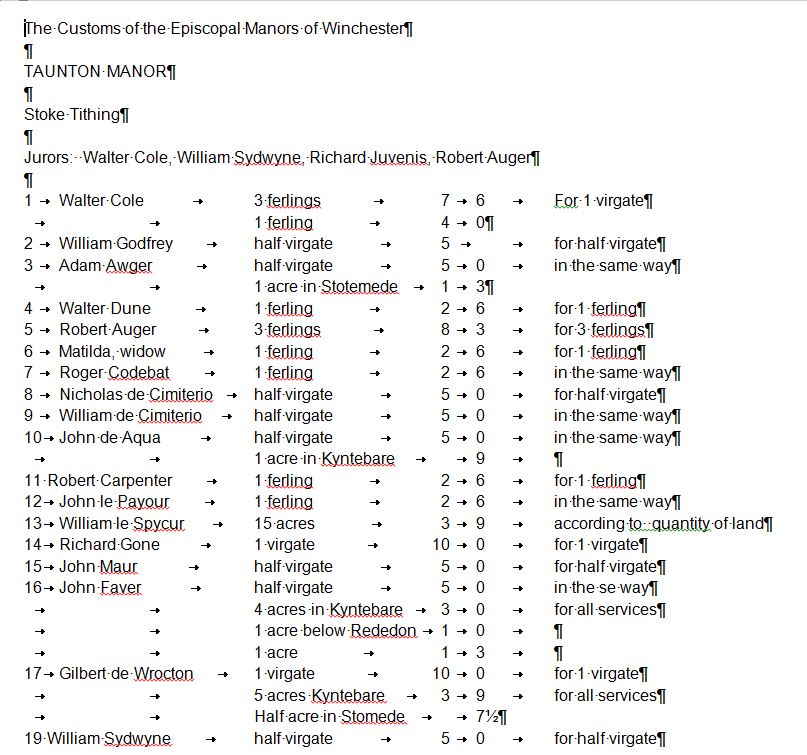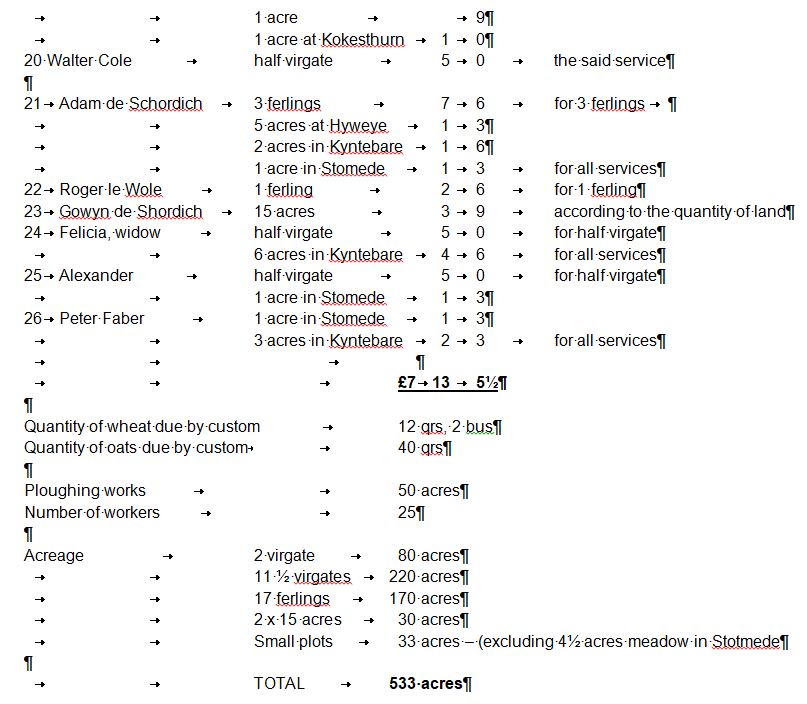





STOKE ST MARY AND DISTRICT HISTORY GROUP


MEDIEVAL STOKE
The period between 1066 and 1485 is often called the Middle Ages. During this time the Manor of Taunton, which covered much of the same land as the current Taunton Deane, was held by the Bishops of Winchester. Other than for a couple of parishes [which luckily Stoke was one] there are no records of Taunton parishes in the Domesday Book, they all come under a general heading of land belonging to the Bishop.
However, once in the ownership of the Bishops, documents do appear giving quite detailed descriptions of holdings in each parish. Pipe rolls, Lay Subsidy Documents, Tithings to name but a few. Some just give total amounts paid by the Parish, others list names and holdings. A large number of these documents are in Archives other than Somerset and all are in latin and written in medieval script, which makes life a little difficult for the amateur historian. However following are the ones that have been translated and are available in Somerset Archives.
Stoke Meadow ?
Knightsbeer ?
The majority of the Bishops’ tenants were personally unfree and held customary holdings by vilien tenure. This meant they were legally tied to the land, could not dispose of their holding as they pleased and were denied access to royal justice. The Bishops’ courts ruled their lives.
SOMERSETSHIRE PLEA
Taken at Ilchester in the 10th year of the reign of King Henry, son of King John [1236]
Tithing of Stoke next Holway
For the flight of Osbert son of John Fine – half a mark [80 d.]
The 1300s were disastrous for the peasants and farming families.
1315 -
Starting with bad weather in spring 1315, universal crop failures lasted through 1316 until summer harvest in 1317; Europe did not fully recover until 1322. It was a period marked by extreme levels of crime, disease, mass death and even cannibalism and infanticide. It had consequences for the church, state, European society and future calamities to follow in the fourteenth century.
In the spring of 1315, unusually heavy rain began in much of Europe. Throughout the spring and summer, it continued to rain and the temperature remained cool. These conditions caused widespread crop failures. The straw and hay for the animals could not be cured and there was no fodder for the livestock. The price of food began to rise.
In the spring of 1316, it continued to rain on a European population deprived of energy and reserves to sustain itself. All segments of society from nobles to peasants were affected, but especially the peasants who represented 95% of the population and who had no reserve food supplies. To provide some measure of relief, draft animals were butchered, seed grain was consumed, children were abandoned to fend for themselves (see "Hansel and Gretel"),
The height of the famine was reached in 1317 as the wet weather continued. Finally, in the summer the weather returned to its normal patterns. By now, however, people were so weakened by diseases such as pneumonia, bronchitis, and tuberculosis, and so much of the seed stock had been eaten, that it was not until 1325 that the food supply returned to relatively normal conditions and the population began to increase again. Historians debate the toll but it is estimated that 10–25% of the population of many cities and towns died.
1348 -
The Black Death swept through towns and villages, and in some cases left no-
1377 Poll tax evidence shows that in the Taunton manors, the population had fallen by 54%.
TOP OF PAGE


Somerset Record Society -

A few of those mentioned above, had land elsewhere -
Kyntebare appears to be newly enclosed land and became “Overland” in later centuries -

Lists of men and women who paid rent on land in the Parish of Stoke.. They may not necessarily all have lived in Stoke
Exchequer Lay Subsidy 20 in the reign of Edward III
Collected in the 20th year of the reign of Edward III [1327]
HUNDRED OF TAUNTON FORINSECUM
STOKE
s. D. Shillings Pence
De Johanne de Brettone xij 12
Simone Grey ij vj 2 6
Johanne Lambard ij 2
Nicholao de Shortdich vj viij 6 8
Willelmo Frensh v 5
Johanne Dun iij iiij 3 4
Cristina Godwyne xij 12
Roberto de Shordich v 5
Waltero Brice ij 2
Thoma de Leche vj 6
Alexandro le B xij 12
xxx 30 shillings
Summa xx villate predicte [Sum of the twentieths of the aforesaid vill]
Interestingly, the sum of 30 shillings is the same amount as levied in the Domesday book in 1086.